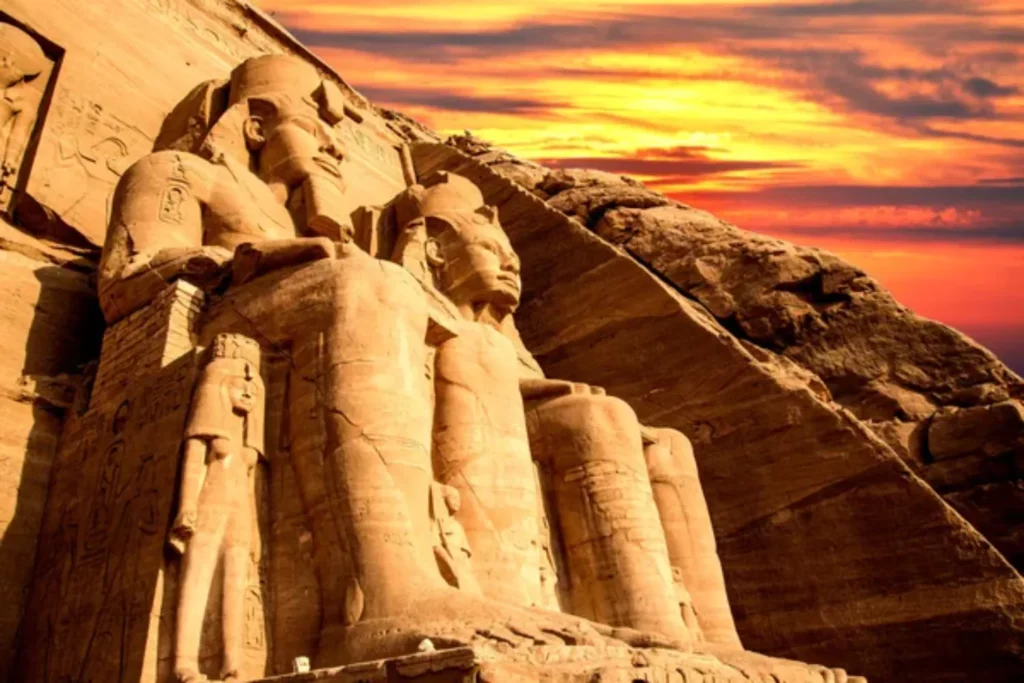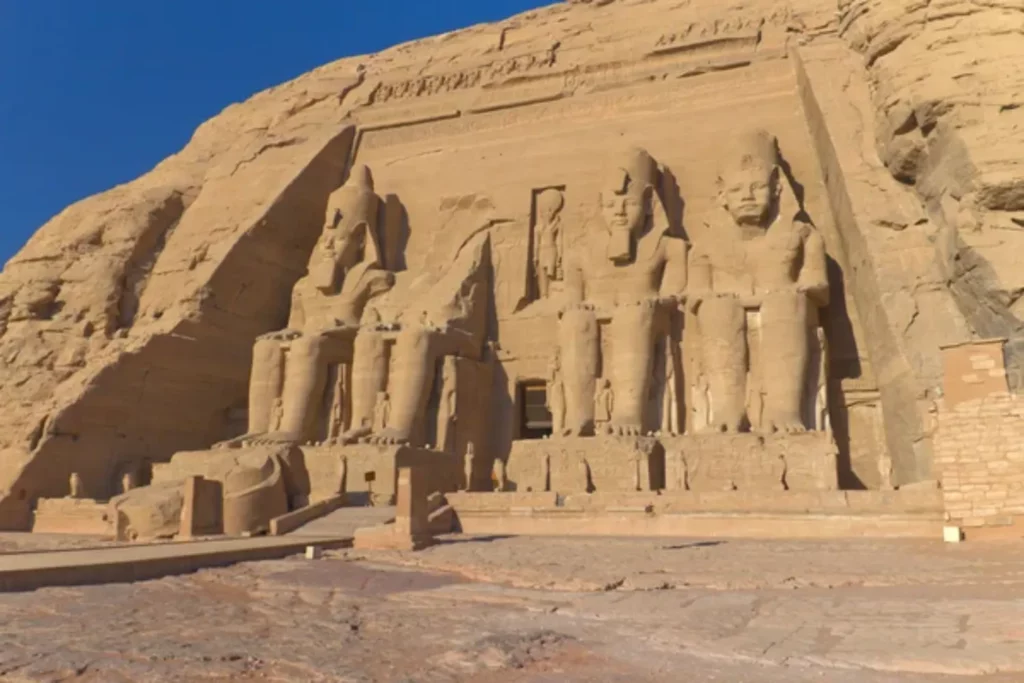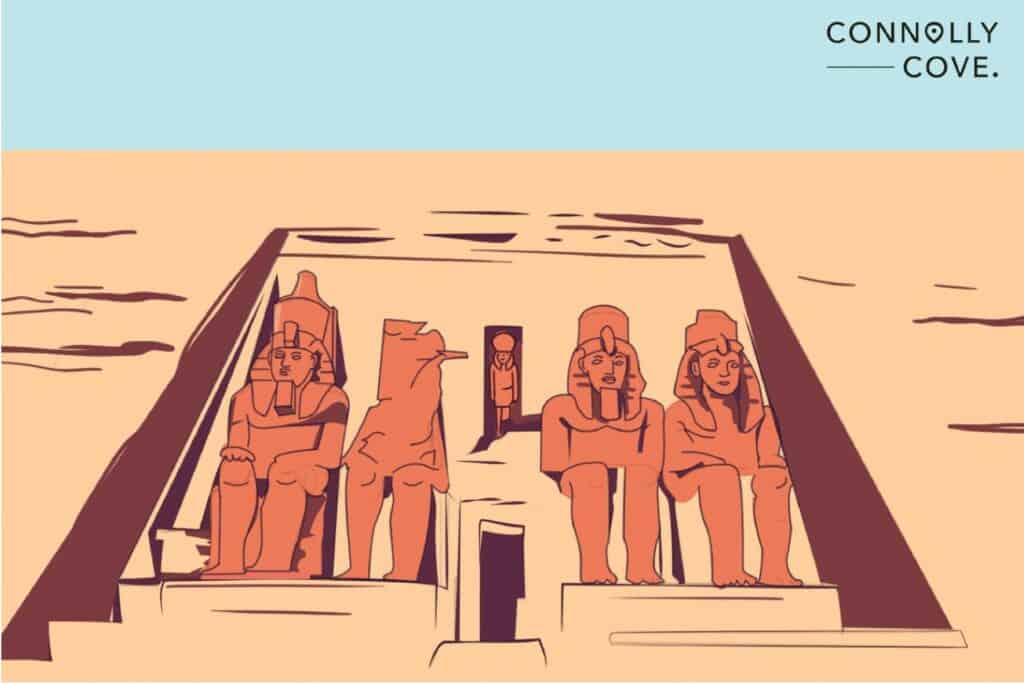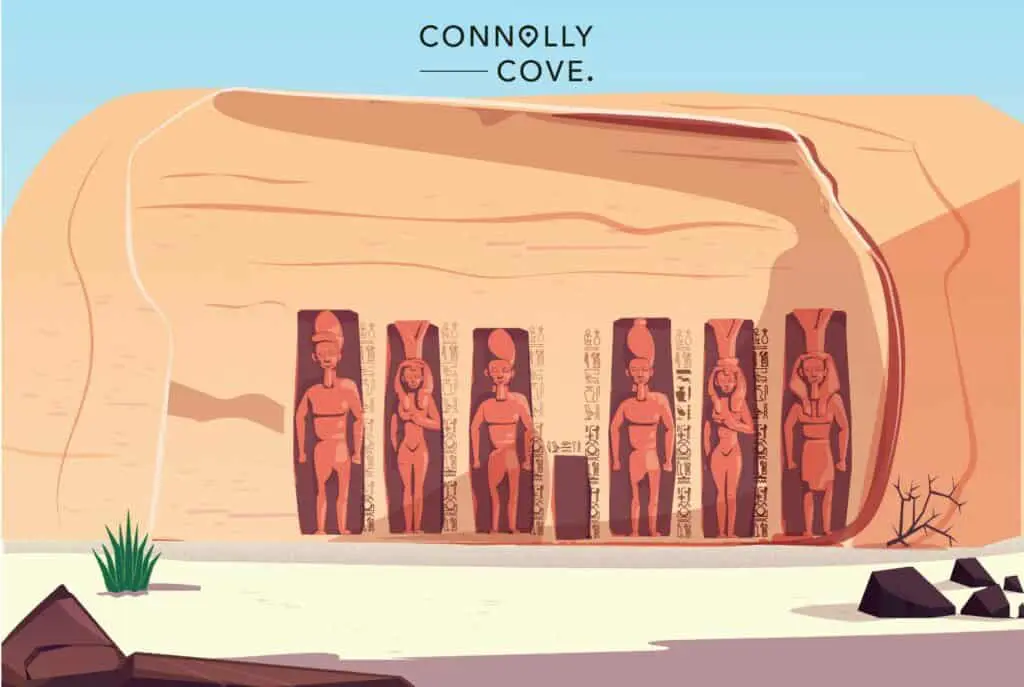The Magnificent Temple of Abu Simbel

Updated On: April 18, 2024 by Ahmed Samir
Reviewed by: Ahmed Samir
Abu Simbel Temple is an important historical site in Egypt, located in the south of Egypt in Aswan city, on the banks of the Nile. The temple is one of the monuments on the UNESCO World Heritage List. The history of the temple construction dates back over 3000 years ago by King Ramses II. During the reign of King Ramses, the temple was carved from the mountains in the 13th century BC. It served as an immortal emblem for him and his wife, Queen Nefertari, and was also a manifestation of celebrating the victory in the Battle of Kadesh. It took 20 years for the Temple of Abu Simbel to be built.
The Temple of Abu Simbel is one of Egypt’s most important tourist destinations, and many people visit it yearly.
The Reason For Naming the Temple Abu Simbel
Many ancient historical and tourist studies indicate that the tour guides were the ones who gave this name to the temple to the legendary child Abu Simbel, who used to see parts of the temple covered by shifting sand from time to time. He was credited with making the explorers reach the temple faster than relying on equipment.

Temple Building Stage
During the reign of King Ramses II, he issued a decision and a big plan for a construction project in Egypt, especially in Nubia, where the city of Nubia was one of the most important cities for the Egyptians and was a source of gold and many expensive commodities.
Therefore, Ramses ordered the construction of many temples carved in the rock near the Abu Simbel area, specifically on the borders of upper and lower Nubia. The first two temples were a temple to King Ramses and the other to his wife, Nefertari. He built the complex of temples in Abu Simbel and took a considerable period of his reign. This complex is considered one of the world’s most beautiful and meaningful archaeological sites.
Over time, the temples became deserted, and no one could approach them. They were buried under the sand until they completely disappeared; they were not discovered until the explorer GL Burkhardt came.
The Movement of Abu Simbel Temple
In the sixties, the Abu Simbel Temple was in danger of drowning due to the High Dam’s construction on the Nile River’s waters. Saving the Abu Simbel Temple began in 1964 AD by a multinational team and many archaeologists, engineers, and heavy equipment operators. The cost of moving the Abu Simbel Temple amounted to about 40 million US dollars.
The site was carefully carved into large blocks weighing about 30 tons, then dismantled and lifted, and reassembled in a new area located 65 metres and 200 metres from the river.
Moving the Abu Simbel Temple was one of the most significant challenges of archaeological engineering. The transfer was also done to save some of the structures submerged in Lake Nasser’s waters.

Abu Simbel Temple Consists of Two Main Temples:
The statues found in the temple features the pharaoh on the throne. His head is in the form of a crown symbolising Upper and Lower Egypt, where the temple initially belonged to the god Amun and the god Ra in addition to Ramses.
In the building front is a large painting detailing the marriage of King Ramses to Queen Nefertari, which led to peace in Egypt. The temple from the inside follows the system of all temples in Egypt, but it includes a small number of rooms.
Abu Simbel Great Temple

It is known as the Temple of Ramses Marmion, which means that Ramses is loved by Amun, an important deity in the time of Ramses II. The grand structure includes four seated statues of King Ramses II wearing a small kilt, a headdress and a double crown with a cobra and borrowed beard. Next to these small statues are the relatives of King Ramses II, including his wife, mother, sons, and daughters. The sculptures are about 20 metres tall.
The temple has a unique architectural design. Its facade was carved into the rock, followed by a corridor leading into the temple. It is carved at a depth of 48 metres into the rock. Its walls were decorated with scenes recording the victories and conquests of the king, including the Battle of Kadesh, and religious backgrounds describing the king in his relations with Egyptian deities.
The importance of the Abu Simbel Temple is based on its association with the sun, which gets perpendicular to the face of King Ramses II’s statue twice a year. The first coincides with his birthday on 22 October, and the second on 22 February, the anniversary of his coronation.
It is a strange and unique phenomenon, the period of the perpendicularity lasts about 20 minutes, and due to the process of moving the temple, this phenomenon is delayed only one day from the original date on which it took place.
Abu Simbel Small Temple

King Ramses II gifted the small Temple of Abu Simbel to Queen Nefertari. It is 150 metres north of the Great Temple, and its facade is decorated with six statues. The statues are up to 10 metres high, four of Ramses II and the other two of his wife and goddess Hathor.
The temple extends into the plateau at a depth of 24 metres, and its interior walls are adorned with a group of beautiful scenes that depict the queen worshipping different gods, either with the king or alone.
These temples picture the ancient Egyptians’ greatness and abilities in ingenious engineering implementation and design, which is still a mystery.
How to Get to Abu Simbel Temple
The temple is a-few-hours-drive south of Aswan, but most tourists get to Abu Simbel by plane. The journey from Aswan takes only 30 minutes, and two flights per day are available so that the traveller gets about two hours to spend in the temples enjoying the fantastic views and ancient civilisation. Abu Simbel temple can be visited by joining the Lake Nasser excursion, as these ships are anchored in front of the temples.
Places That you can Visit Near Abu Simbel
Egypt is full of many beautiful and interesting places to visit, with tons of stories and monuments; luckily, some of the bests are located just near the great Abu Simbel Temple.
Aswan City
Aswan is one of the best tourist destinations for you if you are a fan of calm places. It is one of the most visited cities for temples and historical monuments fans.
Aswan is one of Egypt’s most important tourism centres for recovery from incurable diseases such as bone and skin diseases. One of the most famous is the Isis Island Resort, the Damira area, and Abu Simbel, where the affected parts of the body are buried in yellow sand saturated with sunlight or brown clay for medicinal purposes.
One of the nicest activities that can be done during tourism in Aswan is to enjoy a Nile cruise on a small traditional boat. On the great riverbanks, you can enjoy the incredibly picturesque landscapes between greenery, water, and warm sun in winter.
In addition, you can visit Philae Island, which is famous for including the remains of the Pharaonic temples built in this area for centuries.
Luxor City
One of the essential tourist cities in Egypt is Luxor; it contains one-third of the world’s monuments and many antiquities and archaeological sites that include thousands of artefacts. Tourism in Luxor is purely Pharaonic historical-cultural tourism, as it is one of the oldest civilisations on earth.
Luxor was famous throughout the ages, starting with the ancient state taking it as the capital of Egypt. Many activities attract tourists to visit the city, including hot air ballooning, tours accompanied by a tourist guide, and boarding the Nile cruises, in addition to holding many sports tournaments on its lands, such as the Luxor International Taekwondo Championship.
There are also many archaeological sites such as Karnak Temple, Luxor Temple, Valley of the Kings and Kings, and Luxor Museum. There are great commercial markets where tourists can shop for souvenirs, including antiquities.
Aswan and Luxor are two inseparable tourist destinations, and we advise you to visit them together.
Nubia
Nubia, the country of gold as some call it, is located in the Aswan governorate in southern Egypt. It was named the land of gold because of the country’s treasures and breathtaking nature. The people of Nubia adhered to the Nubian customs and traditions from establishing the Nubian civilisation until today, in addition to the many tourist attractions there.
One of the essential features of Nubia is preserving heritage, even in the construction and design of the houses. It is similar in design to the tourist attractions that express the authentic Nubian person and is characterised by its beauty and design splendour.
The Nubians have beautiful customs and traditions, famous in most parts of the earth, including henna drawing, crocodile tourism, and folk clothes. Among the most important tourist attractions that can be visited in Nubia are the Island of Plants, the Nubia Museum, West Sohail, and many more.






